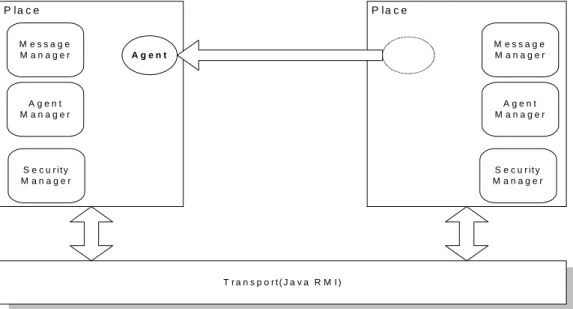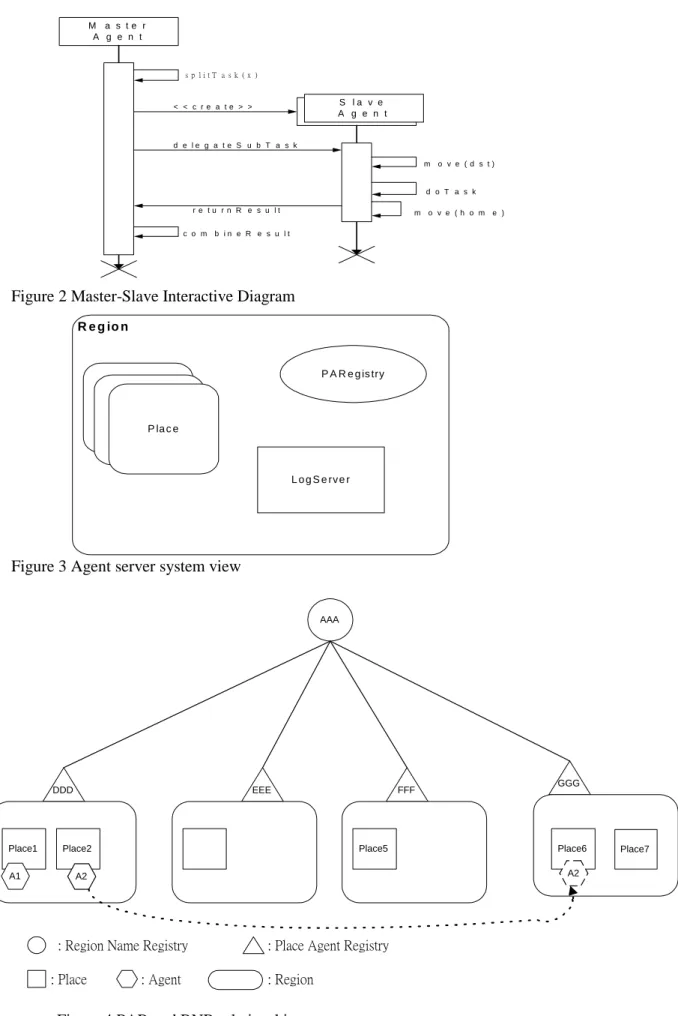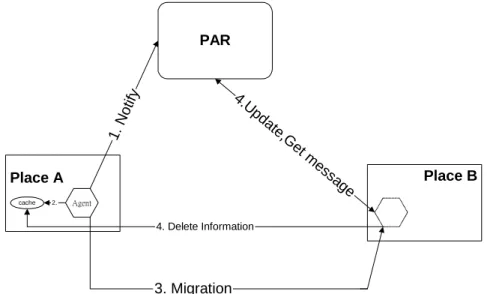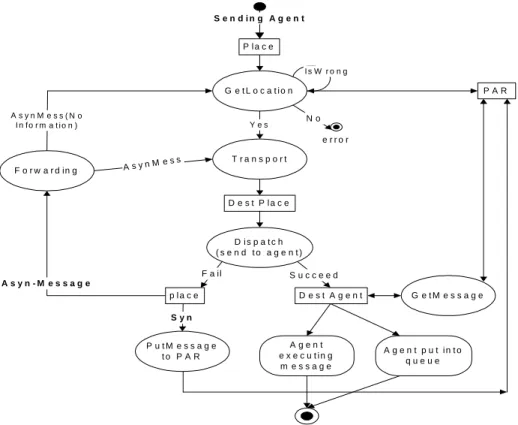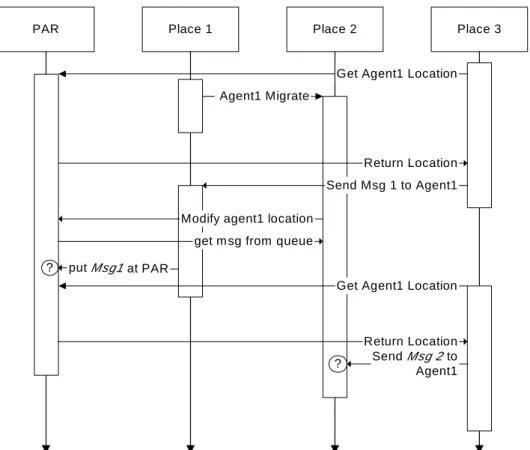行政院國家科學委員會專題研究計畫成果報告
※※※※※※※※※※※※※※※※※※※※※※※
※
※
※
建立一個在網際網路上執行的分散式計算平台
※
※
※
※※※※※※※※※※※※※※※※※※※※※※※
計畫類別:V 個別型計畫 □整合型計畫
計畫編號:NSC 89 –2213 – E – 009 – 138
執行期間: 89 年 8 月 1 日 至 90 年 7 月 31 日
計畫主持人: 王豐堅
共同主持人:
本成果報告包括以下應繳交之附件:
□赴國外出差或研習心得報告一份
□赴大陸地區出差或研習心得報告一份
□出席國際學術會議心得報告及發表之論文各一份
□國際合作研究計畫國外研究報告書一份
執行單位:國立交通大學資訊工程系
中
華
民 國
90 年
12
月
31 日
行政院國家科學委員會專題研究計畫成果報告
計畫編號:NSC 89 –2213 – E – 009 – 138
執行期限:89 年 8 月 1 日至 90 年 7 月 31 日
主持人:王豐堅 國立交通大學資訊工程系
計畫參與人員:陳明豐等研究生
-.
摘 要
代理程式(agent programming)模式在過去幾 年來日益發達,在網路上移動的代理程式 一般稱為移動型代理執行緒(mobile agent), 它與單點上的智慧型代理執行緒(intelligent agents)及程式導向的代理執行緒( program-oriented agents)有可能成為未來程式撰寫與 執 行的 主 流 。 主 要 原 因 是 它 攜 帶 部 分 程 式,具主動性質,可在網際網路上自行達 成單一或多項目標。本期的工作主要是設 計製作一個允許移動行代理執行緒交互溝 通的平台。 關鍵字: 代理執行緒, 移動型代理執行緒, 交 互溝通的平台。 關鍵字: 企業 Java Bean, 伺服器,交易系 統,資料庫,分散式系統.Abstr act
Mobile agent paradigm is getting popular in the past few years. Agent programs communicate with each other or local user to accomplish its goal. Mobile
agent(program)s roam in the network, and,
there needs a mechanism to maintain the location of mobile agents in inter-network.
It is difficult to find a target agent. Besides,
Intelligent agent(program)s can learn
continuously to modify its intension (behavior) based on the belief and desire. Our work describes a new design and the implementation of communication system
for our mobile agent system in order for agents to collaborate with each other more effectively. Our communication system includes both a new name service system
and a new message delivery based on
standard naming/communication
mechanisms. The name service system
works with location tracking, while the
message delivery system handles message deliveries.
Keywor ds: agent programs, mobile agents, communication service system, naming
1. Introduction
Recently, browsing information on World Wide Web is the most popular global service. Internet has more and more software applications to generate and transfer huge amounts of information. Mobile agent is a new paradigm proposed to reduce the programming efforts and network traffic. Mobile agents are programs, which can migrate among machines in a heterogeneous network; they can communicate between and cooperate for each other no matter whether
they are inside a machine or not. Due to migration, an agent can access resource at another host like doing those locally in order to reduce the network bandwidth.
Mobile agent models changes
programming from the rigid client-server model to a more flexible peer-to-peer model, where programs communicate as peers in the same site, depending on their current needs.
Mobility and communication are important factors in cooperation of agents. The platform of mobile agents needs an efficient and reliable communication system. Such a communication system is usually based on a good procedure for locating agents roaming the network and a reliable message delivery mechanism. In general, both mechanisms are complicated because agents can move anytime. For example, the target agent might move to another host after the sending agent gets its location datum. Since the location datum is not correct now and the delivery mechanism needs additional efforts to deliver the message.
In the study, we designed a new communication system in our agent system platform, where the message delivery system is divided into two parts: a
location system associated with the
naming scheme and a message delivery system.
2. Related Wor ks
In order to let code be executed on heterogeneous machines, there are many languages used for implementing agent system before Java was shown in the world [1]. For example, Agent Tcl [3] and Ara (Agent for remote access) [4] are based on the Tool Command Language, and Telescript [5] is from General Magic [10] Inc. JAVA is a better choice of language for agent systems, because it has some features not found in other language for mobile agent systems. With object
serialization in Java, objects can be easily “serialized” and sent over the network or written to disk for persistent storage. There are many commercial Java-based agent systems: IBM Aglets [6], Objectspace voyager3.1 [7], Mitsubishi’s Concordia [8], … , etc. Existing location tracking system can be divided into two parts for discussion: a naming scheme and a location tracking system.
Existing naming schemes can be classified as in (table.1).
Scheme Example Transparency Independence Used by Agent-site+
name
Current.host/MyAgent No No Voyager, AgentTcl Agent-site+id Current.host/9999 No No Aglets, concordia
Name+Home-site
Myagent@Home.site No Yes Our system Table 1. Naming Scheme
A naming scheme is location transparent [12] if the agent name does not contain any site-specific information. For example, a name comprising the site to which the agent belongs plus an agent
identifier (e.g.
dssl.csie.nctu.edu.tw/MyAgent) is not location-transparent. On the other hand, an agent named according to its functions may be location transparent. Example is the name MySearchAgent. A naming scheme is location independent if an agent name can be used to reach the target agent, no matter where it is, and the name is not changed after being created. Note that “location-transparent” does not mean that an agent name cannot contain location-specific information.
Location-dependent naming schemes may allow simpler implementation of name service systems than location-independent ones. Platforms like Agent Tcl, Aglets and Tacoma use location dependent technique to name agents. In these systems a mobile agent is named based on hostname or port number. The name service is resolved using DNS. When an agent migrates, its name would change. For example, in Aglets, if the agent named ssss.csie.nctu.edu.tw/hello
moves to another location
dddd.csie.nctu.edu.tw, its name will change to dddd.csie.nctu.edu.tw/hello. However, the location-dependent naming schemes make the implementation of agent tracking cumbersome. On the other hand, a
location-independent naming scheme requires a name service system to map the symbolic name to the agent’s current location.
A good location tracking system may help
deliver messages quickly and reliably in mobile agent systems. There are several solutions offered today. A simpler solution is to use a unique name server to keep track of all agents [6][15] instead. Cuurent
Solutions have their drawbacks
correspondingly. [6] [8] [15] [16]
3. Our Platform for Agents
The current version of our mobile agent system contains four main components: Agent, Place, Security Manager, and Agent System Management Server.
An agent in our platform, a basic component in the application system, is a JAVA thread
in a place at a time. An agent consists of code and variable states, and auxiliary data as in Table 1. The states describe the agent’s requirements. The dynamic state of an agent includes both site transfer information and
state execution condition. For a move, the agent transfers itself to a new node and continues its execution at some state. If there is a need to restart an agent at a particular execution point, it is done similar to the methodology in Aglets. All agent classes could inherit the basic Agent class, which provides elementary methods or functions for a mobile agent. The attribute agentname for an agent is a unique name controlled by name server that identifies a particular agent object.
Figure 1 Our platform of mobile agents
State Static Attribute
Dynamic state Agent message queue
Code Internal code
Agent methods
Auxiliary Data host-dependent executables Table 2 overview of agent object There are several other mobility patterns discussed in the literature, for example, itinerary, Start-shaped, and Branching [11] etc. Our system contains two basic patterns, sequential and parallel migrations, to derive others [11].
l Sequential Migration:
Here an itiner ar y object maintains a list of destinations, including the next the agent will move to, defines a routing scheme, and handles special cases such as what to do if a destination place does not exist. Objectifying the itinerary allows programmer to save and reuse it later. It is similar to use bookmarks.
l Parallel Migration:
The Master -Slave Pattern [2] allows an agent to spawn several slave agents, which move to the places of different locations for execution in parallel. A slave agent is delegated a task by the master agent. After finishing its task, the slave returns to the place created to report the results to the master agent.
The detailed mechanism of implementing a
mobile agent in JAVA is skipped here.
For Internet programming, a r egion [9] is newly defined for a set of places and agents
of the same agent authority. Each region has one log server to record all behaviors of agents inside, and several register servers (called Place Agent Registry, PAR), each covers several places, to provide information about service agents as in Aglets, voyager, … etc. The log server stores the behaviors in the database using JDBC. Each log entry of the database contains the place location, date, time, and the action of an agent. A PAR is queried by the agents in the same region for finding the agents for communication. A region also contains a Region Name Registry Server (RNR) as a backup server for its PARs.The relationships among places, PAR, Logserver, Region, and RNR are shown in Figures 3
and 4.
4 The Design of a Modified Communication System for Agents
As discussed in Section 2, a name service system provides naming scheme and location tracking services. The design of our modified communication system contains three parts: naming scheme, location tracking and message delivery. The naming scheme guarantees that an agent has a unique name. The major service of location
P l a c e P l a c e M e s s a g e M a n a g e r A g e n t M e s s a g e M a n a g e r S e c u r it y M a n a g e r S e c u r it y M a n a g e r T r a n s p o r t ( J a v a R M I ) A g e n t M a n a g e r A g e n t M a n a g e r
Figure 2 Master-Slave Interactive Diagram
Figure 3 Agent server system view
Figure 4 PAR and RNR relationship
M a s t e r A g e n t < < c r e a t e > > s p l i t T a s k ( x ) S l a v e A g e n t d e l e g a t e S u b T a s k m o v e ( d s t ) d o T a s k r e t u r n R e s u l t c o m b i n e R e s u l t m o v e ( h o m e ) R e g i o n P la c e P A R e g is try L o g S e rv e r AAA DDD EEE FFF GGG
Place1 Place2 Place5 Place6 Place7
A2
A1 A2
: Region Name Registry : Place Agent Registry : Place : Agent : Region
tracking is to find out where an agent is currently. The message delivery mechanism then passes the message to the target agent. 4.1 Our Naming scheme
Our naming scheme contains three characteristics:
1. It allows users to name objects easily. 2. It maps the user-defined name of an
agent to the birthplace so that users can find the location of an agent correctly based on the agent name. 3. The name of an agent is not changed
after the agent is born.
In our naming scheme, we define the
naming format as the following:
Localname@PlaceName
.regionName:port
For example, myHello@Place1.AAA:9999 PlaceName.regionName is the name of an agent’s birthplace and Localname is the name of an agent defined by the generator or programmer. A Localname cannot be used for naming if the name is defined for another agent born at the same place and still alive. The port stands for the entrance of every place at the machine. The string expressing the characteristics can be used for agent’s Localname for better readability. To avoid name duplication for agents, the system is defined two parts. First, DNS (Domain Name System) [14] guarantees that the name (place name.region name) for each place has a unique name. In an intranet environment, a private IP could not have a public domain name at DNS. A RNR server is used to guarantee the uniquesness of region name. Second, each agent has one name only. The birthplace PAR of an agent guarantees the use of Localname when an agent is generated.
4.2 The Mechanism to Tr ack an Agent The management of agents’ location information in our system could be described in three separate phases:
registration (deregistration), migration and
getLocation. When an agent is generated, the agent is registered with the agentname in
the name service system automatically. When the agent terminates, it reports to the name service system to clean the registration. When an agent moves, the agent’s information in the name service system would be updated for request.
As discussed in Section 3, a PAR in a region stores and manages the location information
of agents created in the region. Inside a PAR, an entry of the agent table contains five attributes: agentname, valid bit, current location, message queue, logic clock.
Attribute agentname is the main key in a PAR; each agentname is unique in a PAR. Attribute valid bit is used to indicate whether the agent is moving out now. If
valid bit is false, the agent is moving and
current location is incorrect. The PAR would not reply the location for any agent entry whose valid bit is false. Attribute
Current location stores the place where the agent stays currently. The current location
is (correct and) replied, if valid bit is true. It would be updated once the agent moves successfully. Attribute Message queue
stores the agent’s input messages that arrived at the current location after the agent left. Attribute Logic clock is an integer value used to sequence input messages of an agent. The logic clock variable of an agent entry is increased one by the PAR, each time the clock is queried. The default value is 0.
When an agent is created, the home PAR is informed the information of agentname and current location for registration in the region. The home PAR then checks whether the agentname exists in this region. If no, the PAR adds an entry to store the agentname and location for registration. Otherwise, the registration fails and the system or user gives another name to register again. In case the registration fails too many times, the home PAR would offer an unregistered agentname for successful registration. Notice that the agent name cannot change in an agent’s life. The home PAR deletes an agent entry and asks the RNR server to delete the entry when it receives the termination request. In case there is a message in the entry, it sends a “MessageExisting” message back to the agent additionally,
A successful move for an agent can be divided into five steps in Figure 8. Firstly, an agent notifies its home PAR that it wants to move out. The home PAR changes the
valid bitin the agent entry to false. This is a synchronous step. Secondly, the agent puts the address of destination place into the cache of current place. Thirdly, the code of its code and state is moved to the destination place. Fourthly, if the agent is accepted
(activated) by the destination place, i.e., it first asks the home PAR to update the
current location, and change the valid bit to true in the agent entry. Then, it asks the home PAR to move out the message(s) stored in the message queue to its SYN
message queue. If the move does not succeed, it informs the home PAR to cancel the movement but get the stored message(s) still. Then, it deletes the information in the cache in Step 2. Fifthly, the move method returns “OK” if accepted, or “Fail” otherwise. Place A PAR Place B Agent 1. No tify 3. Migration 4.U pdate,Get mess age cache 2. 4. Delete Information
Figure 5 Successful agent migration phase The location information request in our
system is simple. Our naming scheme allows an agent to get the name of the home PAR of another agent (by the latter’s agentname). Thus, an agent can get the current location of another one by asking the latter’s home PAR. If the valid bit is true, the reply contains the location address.
Otherwise, the reply is
“ AgentMigrating“ by default. In case the agent does not exist, the reply is “The agent does not exist”.
4.3 Message deliver y mechanism
In an agent system, a receiving agent might move during the processing of message delivery. It makes message delivering more complicated than conventional distributed system. Based on our tracking system, the activities of message delivery are divided into synchronous, asynchronous and one-way, where each message is considered from sending agent, receiving agent, and delivery process correspondingly:
l Synchr onous messages For a receiving agent,
If there is no message, it keeps waiting until such a message arrives. Here, an agent is like a server in the client-server model. If there is a message in its SYN message
queue, it processes the message. The queue guarantees first-in-first-use principle.
For a sending agent, when the message delivering completes, the delivering can either be done or fails (as described in step 1.b). In other word, the agent gets an “O.K.” or “fail” message and goes to next step. The delivery of a synchronous message can be described as follows:
1) The sending agent requests the current location of the target agent from the target agent’s home PAR.
a) If the target agent does not exist or has been killed, the PAR returns a failure message.
b) If the target agent is at the migration stage, the sending agent would get a “AgentMigrating” message. Here, the sending agent will start a new request in a fixed time interval continuously until the sending agent gets the location or the time interval present for failure.
2) If the sending agent got the address, the message is sent out to the target agent directly. When the message arrives the place of the target agent,
a)If the target agent moved already, the message is sent to the home PAR of the agent.
sent to the target agent.
(1) The message is the one the target agent is waiting for. The agent is then activated to start its execution.
(2) Otherwise, the message is put at the end of the SYN message queue of the target agent.
l Asynchr onous Messages For a receiving agent,
If there is a message in its ASYN message queue, it processes the message. The step then returns an ‘O.K.’ message. Otherwise, the step returns a ‘no message’. No matter what the step returns, the agent goes to next step after the return.
For a sending agent,
Message sending can be treated Step 1.a and 1.b in the delivery process.
The delivery of an asynchronous message can be described as follows:
1. The sending agent requests the current location of the target agent from the target agent’s home PAR.
(a) If the target agent does not exist or has been killed, the PAR returns a failure message.
(b) If the target agent is at the migration
stage, the sending agent would get a “AgentMigrating” message. The sending agent now starts requesting a location until the PAR returns a failure message (in a fixed time interval).
2. When arriving message is the place of the target agent,
(a) If the target agent exists in the current place, the message is sent to its ASYN message queue.
(b) In case the agent moved and the information of its new place exists in the current place, the message is forwarded to the new place. If the information does not exist, the current place can be treated as the original sending agent and goes to step 1. Note that the current place is also in charge of forwarding the failure message back to the original sending agent. l One-Way Messages
A one-way message is asynchronous and does not block the current execution of the sending agent. The sending agent will not retain a handle for this message, and the receiving agent will never have to reply to
the sending agent.
S e n d i n g A g e n t N o A g e n t e x e c u t i n g m e s s a g e A s y n - M e s s a g e S y n A s y n M e s s ( N o I n f o r m a t i o n ) A s y nM e s s A g e n t p u t i n t o q u e u e S u c c e e d G e t L o c a t i o n T r a n s p o r t P l a c e P A R Y e s D e s t P l a c e D i s p a t c h ( s e n d t o a g e n t ) D e s t A g e n t p l a c e F a il e r r o r P u t M e s s a g e t o P A R F o r w a r d in g I s W r o n g G e t M e s s a g e
In distributed systems, network transporting has some special phenomena. Theoretically, the clock cannot be synchronized for all places in a distributed system, in other words, it is impossible to find out the order of all messages. Practically, a message sent earlier than another one may not arrive at the destination earlier because of network traffic. On the other hand, a server may have more than one entry points. The message arriving earlier may not be guaranteed for service earlier. Logic clock mechanisms provides O(n2) solutions to causal order.[13] To solve the problem, our system provides a simple mechanism to help decide the execution order of arriving synchronous messages only. A PAR’s message queue is used to store the message(s) which arrives at the destination place after the target agent left out in Figure 7. Each agent is defined a
logic clock for the synchronous message in
its home PAR. For the delivery of synchronous messages, when a sending agent asks the target agent’s home PAR the latter’s current location for a synchronous message, the agent also gets a timestamp from the PAR. On the other hand, the PAR increases logic clock variable by one at the same time.
In message handling aspect, an agent is defined a synchronous message queue and is also associated with a timestamp queue where each element indicates whether the corresponding message is “executed”, “arrived but not executed”, or “not arrived yet”. The queues are implemented with arrays and two indices. The first index points to the oldest message that is not arrived and served. The second index points
to the biggest timestamp to show the latest message being received. When processing a message, the agent searches the timestamp queue to find the oldest message for the corresponding entry. The search starts from the first index and completes at the second index. If there is no message, the agent waits in a fixed time interval, gets the message(s) from its home PAR, and then starts next searching. If such a message exists, the agent modifies the corresponding element in timestamp queue as “executed” and processes the message. If the first index equals second, no message needs to be served and the agent repeats above (wait, get, start) activities till a candidate message arrives.
When the agent receives the messages, it also lets the second index be modified to get the newest timestamp and updates the elements added in timestamp queue if a timestamp of the message is bigger than the second index. Here, if an element whose message exists already, the element is not changed. If an element whose message is received now, the element is set “arrived but no executed”. If an element whose message is not in, the element is set “not arrived”. Our method has some defects. For example, an agent might crash when it waits for the candidate message that is lost. An agent asking earlier than another one may not get a smaller timestamp than another one because of network traffic. In case the target agent doesn’t move, the sending agents get the same location and timestamps from the home PAR. It wastes the PAR’s time execution and network traffic. 5. Conclusion and futur e wor k
Thereport presents the design of a communication platform for mobile agents and a system
has been implemented in our lab. It supports the agent location tracking and offers a more
reliable and efficient mechanism for delivering messages to mobile agents than previous versions [16][17].
There is a defect for synchronous message passing in the system: the message queue in a PAR. When a message reaches the destination place, the target agent may leave already, and thus the message is sent to the agent’s home PAR. In case that the target agent does not move, it will not ask the home PAR and thus the message will stay in the home PAR too. This may not be efficient because the target agent might not move for a long.
One solution to this problem is to design a mechanism that allows a PAR to check whether its registered agent stays at the same location for a fixed time. The PAR sends the messages to the agent if the answer is “the same place”. Another solution to this problem is to let the agent gets the message from the home PAR when it finds out some message not received for handing. Both mechanisms introduce additional problems for the system still and no discuss further.
PAR Place 1 Place 2 Place 3
Agent1 Migrate
Get Agent1 Location
Return Location Send Msg 1 to Agent1
Get Agent1 Location
Return Location
Send Msg 2 to
Agent1 Modify agent1 location
get m sg from queue put Msg1 at PAR
? ?
Figure 7 Situation of Message Arriving Refer ence
[1]”Software Agents: A review”, Shaw Green, Leon Hurt etc.
[2] Programming and Deploying Java Mobile Agents with Aglets, Danny B. Lange
and Mitsuru Oshima
[3] Agent Tcl was developed by Robert S. Gray and colleagues at the Dartmouth College Computer Science Department . [4] Ara is a project within the Distributed Systems Group in the Computer Science Department of the University of Kaiserslautern, Germany.
http://www.uni-kl.de/AG-Nehmer/Projekte/Ara/index_e.html
[5] James E. White; Telescript technology: The foundation for the electronic
market place; General Magic White Paper.
[6] IBM Aglets, http://www.trl.ibm.co.jp/aglets [7] Voyager 3.1, http://www.objectspace.com [8] Concordia, http://www.meitca.com/HSL/Projects/Conc ordia
[9] MASIF-The OMG Mobile Agent System Interoperability Facility; Mobile
Agents–Second International Workshop, MA’98 (Stuttgart, Germany, September 1998); Published as Kurt Rothermel and Fritz Hohl, editors, Lecture Notes in Computer Science, 1477. Springer, September 1998.
[10]Mobile Agents White Paper, General Magic,
http://www.genmagic.com/technology/te chwhitepaper.html/
[11] Agent system Development Method Based on Agent Pattern; Yasuyuki Tahara, Akihiko Ohsuga and Shinichi Honiden; 21st International Conference on Software Enigeering, 16-22 May 1999.
[12] Distributed Systems: concepts and Design; George Coulouris, Jean Dollimore, and Tim Kindberg; second edition 1994 [13] Distributed Operation Systems & Algorithms; Randy Chow and Theodore Johnson at university of Florida; publisher Addison Wesley 1997
[14] HOSTNAME Server; Tech. Report RFC 953; ftp://nic.ddn.mil/user/pub/RFC [15] Mobile Objects and Agents (MOA); Dejan S., William LaForge and Deepika Chauhan; The Open Group Research Institute
